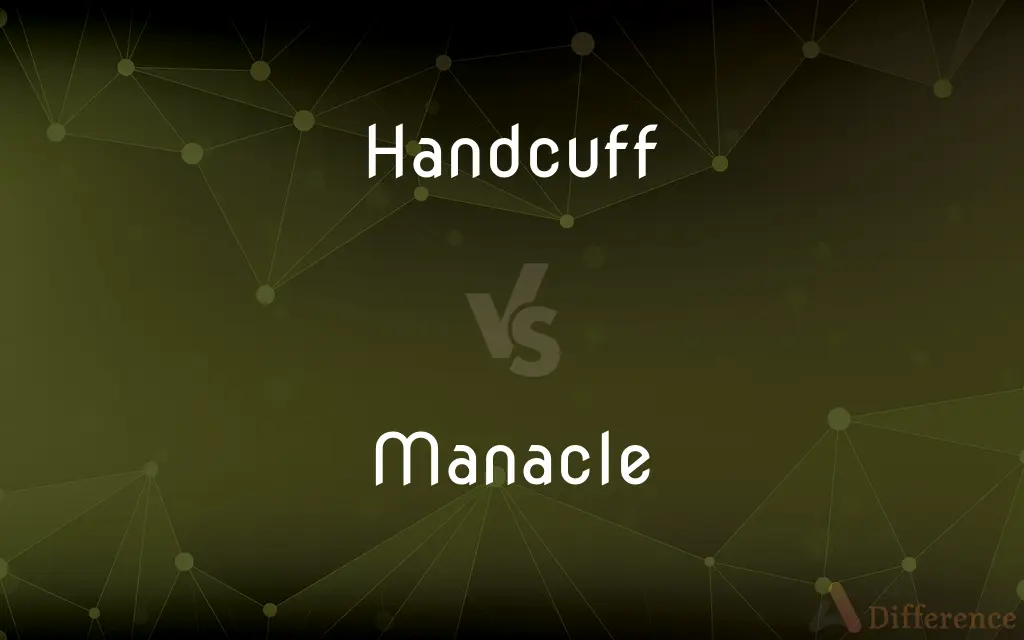Handcuff vs. Manacle — What's the Difference?
By Tayyaba Rehman & Urooj Arif — Updated on March 20, 2024
Handcuffs are restraining devices used primarily by law enforcement, while manacles are older, broader terms for shackles used on prisoners.

Difference Between Handcuff and Manacle
Table of Contents
ADVERTISEMENT
Key Differences
Handcuffs are designed specifically for restraining the wrists, typically used by police or security personnel to secure individuals temporarily. These devices are adjustable, lockable, and are often made of metal, designed to ensure the detainee's limited mobility without causing undue harm. Manacles, on the other hand, refer to a broader category of metal restraints that can be used on both wrists and ankles. They are an older term that conjures images of medieval dungeons or historical punishment methods.
Handcuffs are a symbol of modern law enforcement and are used worldwide for the temporary detainment of suspects. Unlike handcuffs, manacles are not exclusively used by law enforcement and can be associated with long-term detainment or even torture. They can vary greatly in design, from simple iron bands to more complex locking mechanisms.
While handcuffs are generally considered tools of restraint for temporary and lawful detainment, manacles have a more varied and often darker history, associated with permanent confinement, slavery, or torture. This distinction is not just historical but also reflects the evolution of restraint devices from punitive instruments to tools of law enforcement.
The use of handcuffs is governed by legal and ethical standards, ensuring that their application is justified, humane, and temporary. In contrast, the use of manacles in the past often lacked such regulations, reflecting a time when punishment and detainment practices were harsher and less humane.
Despite their differences, both handcuffs and manacles serve the primary function of restraining movement. However, handcuffs are seen as a necessary and regulated tool in modern law enforcement, while manacles are more likely to evoke historical or punitive connotations.
ADVERTISEMENT
Comparison Chart
Primary Use
Temporarily restraining individuals by law enforcement
Restraining prisoners or slaves, historically broader use
Material
Typically metal, sometimes with padding
Mainly metal, can be more varied
Design
Adjustable, lockable, for wrists
Can be for wrists or ankles, often less adjustable
Connotation
Law enforcement, temporary detainment
Historical punishment, slavery, long-term confinement
Legal and Ethical Standards
Governed by modern standards to ensure humane treatment
Often associated with harsher, less regulated practices
Compare with Definitions
Handcuff
Temporary restraint.
Handcuffs are designed for temporary, safe detainment during legal procedures.
Manacle
Punitive connotations.
In history, manacles were often used as a form of punishment rather than mere detainment.
Handcuff
Safety features.
Some handcuffs come with padding to prevent injury to the detainee's wrists.
Manacle
Versatile application.
Manacles can be used to shackle both wrists and ankles, limiting movement more extensively.
Handcuff
Law enforcement tool.
The officer used handcuffs to secure the suspect during the arrest.
Manacle
Varied designs.
Manacles come in various designs, some being simple iron bands, while others have complex locking mechanisms.
Handcuff
Symbol of authority.
Handcuffs are often seen as a symbol of law enforcement authority and control.
Manacle
Historical restraint device.
Manacles were commonly used in medieval dungeons to restrain prisoners.
Handcuff
Adjustable and lockable.
Modern handcuffs are adjustable to fit different wrist sizes and can be securely locked.
Manacle
Association with slavery.
Manacles were used to shackle slaves, symbolizing oppression and lack of freedom.
Handcuff
A restraining device consisting of a pair of strong, connected hoops that can be tightened and locked about the wrists and used on one or both arms of a prisoner in custody.
Manacle
A device for confining the hands, usually consisting of a set of two metal rings that are fastened about the wrists and joined by a metal chain.
Handcuff
To put handcuffs on (a person).
Manacle
Something that confines or restrains
"caught in the manacles of their language" (Cynthia Ozick).
Handcuff
To restrain or render ineffective.
Manacle
To put manacles on (someone); restrain with manacles.
Handcuff
One ring of a locking fetter for the hand or one pair.
Manacle
To restrain the action or progress of
"[She was] manacled by the restrictions of an overbearing father" (Lilian Faderman).
Handcuff
To apply handcuffs to
Manacle
A shackle for the wrist, usually consisting of a pair of joined rings; a handcuff; (by extension) a similar device put around an ankle to restrict free movement.
Handcuff
(figuratively) to restrain or restrict.
Dang, I’m handcuffed by these regulations. I’d like to help but it’d be illegal.
Manacle
(figuratively) A fetter, a restriction.
Handcuff
A fastening, consisting of an iron ring around the wrist, usually connected by a chain with one on the other wrist; a manacle; - usually in the plural.
Manacle
(ambitransitive) To confine with manacles.
Handcuff
To apply handcuffs to; to manacle.
Manacle
A handcuff; a shackle for the hand or wrist; - usually in the plural.
Doctrine unto fools is as fetters on the feet, and like manacles on the right hand.
Handcuff
Shackle that consists of a metal loop that can be locked around the wrist; usually used in pairs
Manacle
To put handcuffs or other fastening upon, for confining the hands; to shackle; to confine; to restrain from the use of the limbs or natural powers.
Is it thus you use this monarch, to manacle and shackle him hand and foot ?
Handcuff
Confine or restrain with or as if with manacles or handcuffs;
The police handcuffed the suspect at the scene of the crime
Manacle
Shackle that consists of a metal loop that can be locked around the wrist; usually used in pairs
Manacle
Confine or restrain with or as if with manacles or handcuffs;
The police handcuffed the suspect at the scene of the crime
Common Curiosities
Why do manacles have a negative connotation?
Manacles are associated with historical punishment, slavery, and torture, reflecting less humane practices of the past.
Are handcuffs designed to be safe?
Modern handcuffs are designed with safety features, such as adjustability and padding, to prevent injury.
What are handcuffs used for?
Handcuffs are used by law enforcement to temporarily restrain individuals during arrest or detainment.
Were manacles only used in medieval times?
While often associated with medieval times, manacles have been used throughout history for various purposes, including into the modern era in some contexts.
Is it legal for civilians to own handcuffs?
Ownership laws vary by location, but in many places, civilians can legally own handcuffs, though using them on another person without justification can be illegal.
What makes manacles different from handcuffs?
Manacles are a broader category of restraints used historically for various purposes, including punishment and slavery, not limited to law enforcement.
How are handcuffs removed?
Handcuffs are removed using a key that unlocks the locking mechanism, typically carried by the law enforcement officer.
Were manacles ever considered humane?
Historically, the concept of humane treatment varied significantly, and manacles were used as standard practice without the same considerations of humaneness present today.
Can manacles be used on ankles?
Yes, manacles can be designed to shackle both wrists and ankles, unlike handcuffs, which are primarily for wrists.
How did ancient civilizations use manacles?
Ancient civilizations used manacles for various purposes, including detainment, punishment, and displaying power over captives.
Can handcuffs be used in self-defense?
Handcuffs are primarily a tool for law enforcement, and using them for self-defense requires specific legal justification and knowledge of their lawful application.
Do police use manacles today?
Modern law enforcement primarily uses handcuffs, not manacles, due to legal and ethical standards governing detainment practices.
Can handcuffs be picked or broken?
While handcuffs have locking mechanisms, attempts to pick or break them are illegal and can result in injury.
Do all handcuffs look the same?
While there is a standard design, handcuffs can vary in material, size, and features, such as double locking mechanisms or padding.
What materials are modern handcuffs made of?
Modern handcuffs are primarily made of steel, sometimes coated with nickel or other materials for durability and to prevent corrosion.
Share Your Discovery

Previous Comparison
Lottery vs. Raffle
Next Comparison
Often vs. SometimesAuthor Spotlight
Written by
Tayyaba RehmanTayyaba Rehman is a distinguished writer, currently serving as a primary contributor to askdifference.com. As a researcher in semantics and etymology, Tayyaba's passion for the complexity of languages and their distinctions has found a perfect home on the platform. Tayyaba delves into the intricacies of language, distinguishing between commonly confused words and phrases, thereby providing clarity for readers worldwide.
Co-written by
Urooj ArifUrooj is a skilled content writer at Ask Difference, known for her exceptional ability to simplify complex topics into engaging and informative content. With a passion for research and a flair for clear, concise writing, she consistently delivers articles that resonate with our diverse audience.
















































